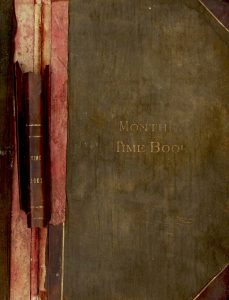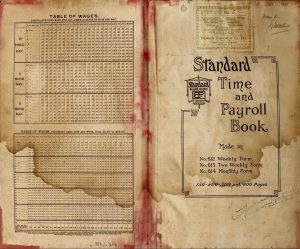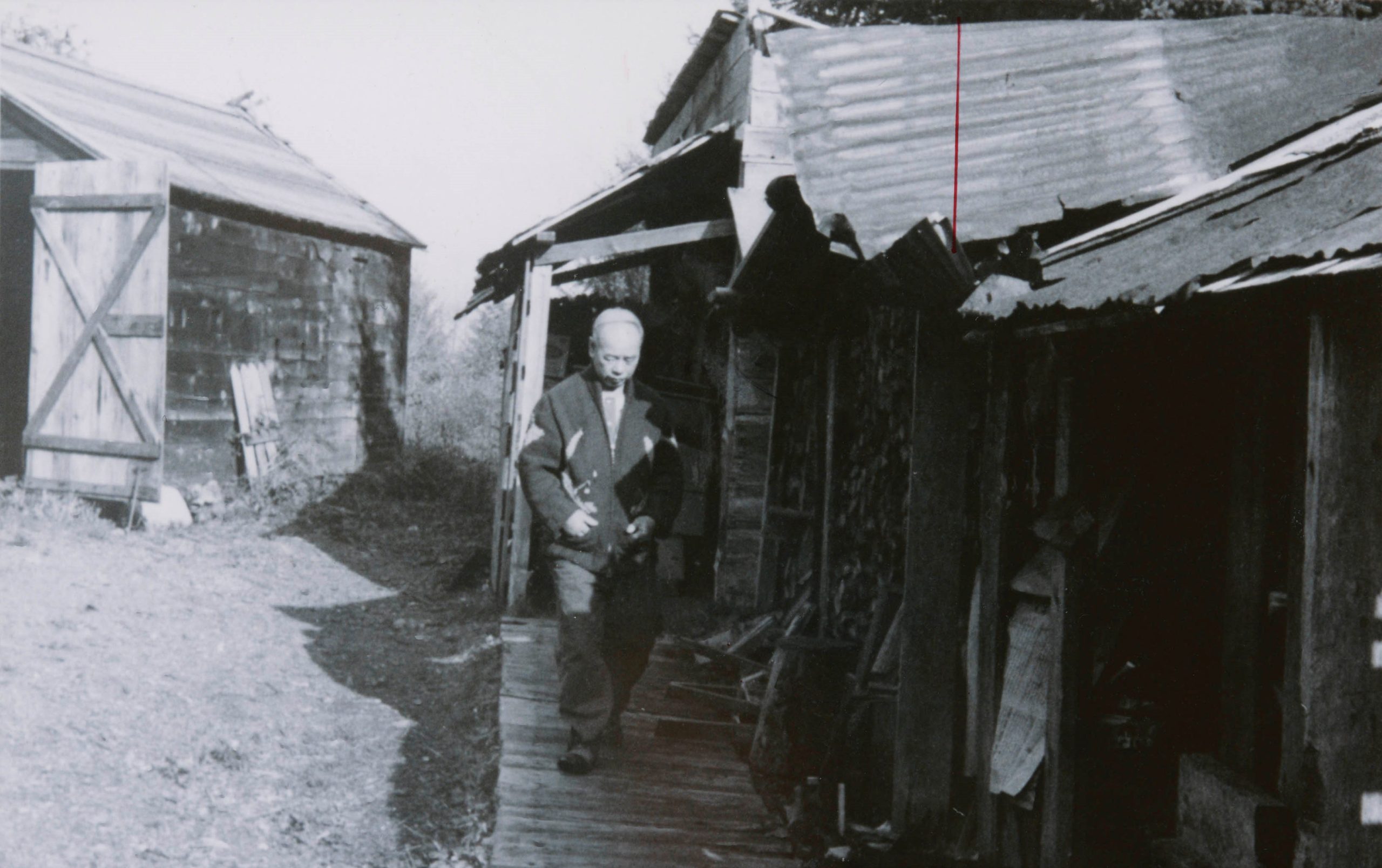In the spirit of Asian Heritage Month and its 2024 theme, “Preserving the Past, Embracing the Future: Amplifying Asian Canadian Legacy,” the South Asian Canadian Digital Archive (SACDA) team would like to share our archival journey of documenting the Chinese Canadian sawmill workers of Paldi.

Paldi, the first intercultural town in Canada, is a small lumber mill town on Vancouver Island in British Columbia. It was formed in 1918 by Mayo Singh and 34 other shareholders, primarily recent Sikh immigrants from Punjab, India to build an economic hub of forestry activity. A thriving intercultural community of over 1,500 residents at its peak, Paldi was home to migrants from India, Japan, China, and Europe. SACDA, in partnership with the BC Forest Discovery Centre, digitized and described the Mayo Lumber Company payroll book from 1915 – 1917.


The Mayo Lumber Company payroll book is believed to be the first official account of the Mayo Lumber Company. The original physical book was in the holdings of the BC Forest Discovery Centre in Duncan, BC. During a visit to the centre last year, curator Neil Malbon kindly shared the book with us for digital preservation. The book consists of 51 pages and is in fragile condition. It was meticulously digitized and processed by SASI’s co-op student, Rashneet, using a Canon 5D Mark II with prime lenses and a photobox. The images were later edited with Adobe Lightroom and Photoshop, and three preservation file formats were created for long-term preservation and access. The payroll book documents the names of the workers, working hours, hourly rates, total monthly income, and the evolution of their hourly rates over time. The signature column includes signatures of the workers in multiple languages including Chinese, Japanese, Panjabi, and English.
 Rui Lu, a practicum student from the Department of Information Studies at the University of the Fraser Valley as part of her LIBT 266 course, conducted archival and metadata research to describe the Mayo Lumber Company payroll book. This included creating item-level metadata for the payroll book. Rui states, “Although I had learned the core theories and rules of archive description and practiced them through coursework assignments, applying this knowledge in real practical scenarios proved to be a different experience. Classroom instruction and textbook theories did not adequately prepare me for describing a document record that is over a century old, bearing numerous stains, blurred writing, and letters that are challenging to decipher.”
Rui Lu, a practicum student from the Department of Information Studies at the University of the Fraser Valley as part of her LIBT 266 course, conducted archival and metadata research to describe the Mayo Lumber Company payroll book. This included creating item-level metadata for the payroll book. Rui states, “Although I had learned the core theories and rules of archive description and practiced them through coursework assignments, applying this knowledge in real practical scenarios proved to be a different experience. Classroom instruction and textbook theories did not adequately prepare me for describing a document record that is over a century old, bearing numerous stains, blurred writing, and letters that are challenging to decipher.”
One of the important metadata tasks that Rui completed was to identify, document, and research the names of the Chinese Canadian sawmill workers from the Mayo Lumber Company payroll book. Professor Henry Yu from the Department of History at the University of British Columbia shared with SACDA the Chinese Head Tax database with information detailing 97,114 individuals who arrived in Canada from 1885 to 1949. We corroborated the names and other available information from the payroll book with the Chinese Head Tax database and were able to identify and confirm the names of 19 Chinese Canadian sawmill workers who worked at the Mayo Lumber Company in Paldi from 1915 to 1917.

| name_payrollBook | signature | signature_language | name_translationEnglish |
| Ya[?]g | 底制 | chn | Illegible
|
| Ch[?] | 底制 | chn | Illegible |
| Ah Lay | 杨礼 | chn | Pinyin: Yang Li |
| Ah Him | chn | Chinese signature illegible | |
| Ah You | 祐 | chn | Pinyin: You |
| (Ah) L[?]g | L[?]g 安 | eng; chn | Signature includes both English and Chinese |
| Long Den | 梁端 | chn | Pinyin: Liang Duan |
| Ah Choy | [?] oy | eng | |
| Koo Him | chn | Chinese signature illegible | |
| Choy on | 安 | chn | Pinyin: An |
| Lang You | 祐 | chn | Pinyin:You |
| Chong Bue | eng | English signature reads L[?] Some | |
| Lee Yun | 容 | chn | |
| Yang Ban | 杨 | chn | |
| Ah Hoy | Hoy | eng | |
| Nho [?]in | 刘乾 | chn | Pinyin: Liu Qian |
| Low Lum | Low Lum | eng | |
| Low L[?]k | 陆 | eng | Pinyin: Lu |
| Long Poy | [?] 沛 | chn | Pinyin: Long Pei |
(Sample local authority records from SACDA)
In her final practicum reflection report, Rui describes her experience, “Despite the considerable effort required for this task, I gained valuable insights throughout the process. I discovered that many Chinese names were recorded as ‘Ah’ followed by a given name in the payroll book. However, ‘Ah’ did not represent the last name or first name of these Chinese workers. In Southern China, particularly in the Guangdong-Hong Kong region, it is customary among family and friends to address each other by adding the prefix ‘阿’ (pronounced as ‘a’) before their name. For example, if someone’s full name is Yang, Li, friends might affectionately call him ‘阿礼’ (Ah Li). While this practice is viewed as a friendly and endearing way to address one another, it sometimes results in the loss of family names over time.”


An example of a name beginning with “Ah” from the payroll book, SACDA 2023_13_02_02.
As part of this archival and digital preservation processing work, the team created and developed a local thesaurus and authority list that reflect the unique intercultural histories of the Asian and South Asian workers of Paldi. Further archival and metadata research is planned to document the Panjabi and Japanese names from the Mayo Lumber Company payroll book. The South Asian Studies Institute is currently traveling its Haq and History exhibit to the Nikkei National Museum & Culture Centre who have added to the exhibit with research on Japanese families of Paldi. The exhibit will be launched at Nikkei National Museum in November 2024 and the Mayo Lumber Company ledger will be on display.
With grateful thanks to:
- Neil Malbon, Curator, BC Forest Discovery Centre
- Karen Sharkey, Assistant Professor, Department of Information Studies, University of the Fraser Valley
- Dr. Henry Yu, Professor, Department of History, University of British Columbia


This is so fascinating. I grew up in Duncan (late 1950’s) and, as a white person, knew virtually nothing about Paldi, other than that it existed and was where many Indo-Canadians lived and worked. Thank you for this valuable research.
I was hoping to learn from this intriguing piece how the Chinese workers found their jobs in the Paldi forest industry. Were they welcomed by the other workers? Were they paid at the same rate as the non-Chinese workers? Were there perhaps marriages between the Chinese men and non-Chinese women?